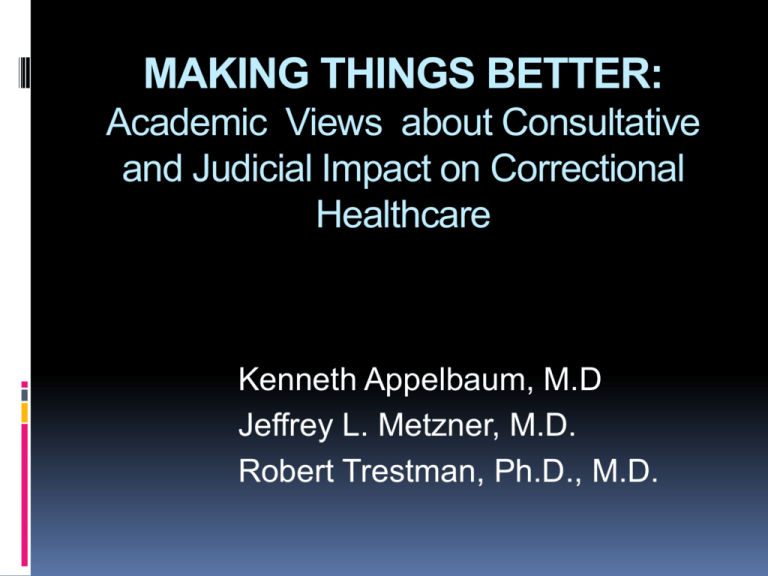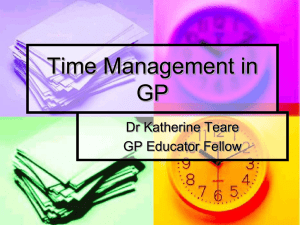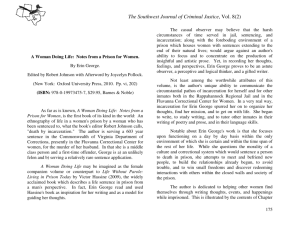Making Things Better: Academic Views about
advertisement

MAKING THINGS BETTER: Academic Views about Consultative and Judicial Impact on Correctional Healthcare Kenneth Appelbaum, M.D Jeffrey L. Metzner, M.D. Robert Trestman, Ph.D., M.D. DISCLOSURES THE AUTHORS HAVE NO CONFLICTS OF INTEREST TO DISCLOSE OBJECTIVES: By the end of the seminar, participants will: Become familiar with definitions and applications of consultations, technical assistance, settlement agreements and consent decrees in correctional healthcare Understand opportunities to optimize system benefits from these various interventions Discuss and share experiences with these interventions, particularly as they have engaged academic opportunities and benefit 1: History Right to treatment cases Cooper v. Pate (1964), Ruiz v. Estelle (1980) Bowring v. Godwin (1977) Bell v. Wolfish (1979) Estelle v. Gamble (1976) Section 1983 lawsuits These cases are filed under Section 1983 of Title 42 of the U.S. Code. Section 1983 lawsuits stem from legislation passed by the U.S. Congress after the Civil War to protect Southern African-Americans from reprisals during Reconstruction. Early prison cases Newman v. Alabama (1977) was the first case won on the theory that the totality of conditions in the prison constituted cruel and unusual punishment. Estelle v. Gamble made it clear that a single episode of medical malpractice was not equivalent to deliberate indifference (i.e., was not a constitutional violation). The Civil Rights of Institutionalized Persons Act of 1980 (CRIPA, 1980) Title 42 also includes Section 1997, the Civil Rights of Institutionalized Persons Act of 1980 (CRIPA, 1980), which empowers the U.S. Department of Justice to conduct investigations and litigation relating to conditions of confinement on behalf of a class of institutionalized persons in state or locally operated institutions when there is evidence of civil rights deprivations. 2: Technical Assistance and Consultations What is TA? How to get it What to expect 2: Technical Assistance and Consultations What is TA? Technical assistance is the coordinated effort of providing funding, training, research, and consulting to address specific issues. 2: Technical Assistance and Consultations advisory capacity works with the staff to assess programs and operations, implement advanced practices, and improve overall agency operations, management, programming and services. http://nicic.gov/TA 2: Technical Assistance and Consultations Assess programs and operations. Implement effective practices. Improve agency management, operations, and programming. Refine the design, delivery, management, and evaluation of staff training programs. Cover the costs of practitioners' visits to another agency to observe effective practices. http://nicic.gov/TA 2: Technical Assistance and Consultations Most direct technical assistance requires onsite at the agency for an average of 3–5 days. The cost of each direct technical assistance event may not exceed $10,000 http://static.nicic.gov/Library/022876.pdf 2: Technical Assistance and Consultations Examples: Managing Mental Illness in Segregation Units Training staff in Motivational Interviewing Developing Medication Assisted Therapy Suicide Risk Reduction And . . . 3: Interventions Court orders following a trial Consent decree The Prison Litigation Reform Act (PLRA) of 1996, 18 U.S.C. Section 3626 (b.)(2) The PLRA has had a negative impact on the legal claims process of inmates. The PLRA established new procedural requirements for litigation by prisoners and significantly limited the ability of the courts to order relief. The impact of the PLRA Private Settlement Agreements Current litigation Has generally become more narrowed in focus. Correctional mental health system only Mental health system in supermax prisons or in segregation units only Settlement Agreements: Standard Elements The access concept Cohen, F. (2008). The mentally disordered inmate and the law 2nd ed. Kingston, NJ: Civic Research Institute. The three elements identified for establishing access in a constitutionally adequate correctional mental health system include the following: (1) adequate physical resources regarding treatment program space and supplies, (2) adequate human resources concerning numbers of properly trained and/or experienced mental health staff who will identify and/or provide treatment to inmates with serious mental illness, and (3) adequate access for inmates to the physical and human resources within a reasonable period of time. Staffing plan Prison X shall ensure clinically appropriate and timely treatment for inmates whose assessments reveal serious mental illness or serious mental health needs, including timely and regularly scheduled visits with Qualified Mental Health Professionals or with Qualified Mental Health Staff, with appropriate, on-site supervision by a Qualified Mental Health Professional. Physical Plant Prison X shall ensure timely provision of therapy, counseling, and other mental health programs for all inmates with serious mental illness. This includes an adequate array of structured therapeutic programming. Prison X will develop and implement policies and procedures defining the various levels of care and identifying the space, staffing, and programming that are appropriate to each identified level of care. Quality Improvement QA is one aspect of QI QI needs to involve healthcare and custody staff at all levels Impact on system Institutional cultural changes Increased resources Safer environment Better healthcare and better security 4a: Preparing for the monitoring visits Self-monitoring of the Settlement Agreement (SA) should be an ongoing process, not just episodically driven by monitoring visits. Prioritize efforts to achieve compliance with elements of the SA. You should know more about your system than the Monitor. Develop reliable management tools Need an electronic data base for management purposes and QI purposes. Engage your supervisors and line staff in the process Provide a status update to every provision of the SA with proof of practice data readily available. 4b: Preparing for the monitoring experience Review the agreement/ decree in detail Understand the Process Establish working groups with empowered team leaders Building trust 4b: Preparing for the monitoring experience Supporting change in corrections: If you think change can never happen, remember smoking! 4b: Preparing for the monitoring experience Gather data consistent with each element of the decree/ agreement When in doubt, discuss with your attorneys/ AAG’s Coordinate and build consensus 4b: Preparing for the monitoring experience Problem solve Engage staff proactively: Avoiding a 5th Column through transparency Conduct a Mock visit: full Dress Rehearsal Use this as an opportunity 5: Academic Opportunities Education Clinical Initiatives Program Evaluation and Research 5: Academic Opportunities: Education Involve faculty Student involvement Staff As educators of students As students themselves 5: Academic Opportunities: Clinical Initiatives Quality Improvement Implementation of Evidence Based Practice Publishing results and process improvement 5: Academic Opportunities: Program Evaluation and Research Evaluation Design linked to QA and QI Research Studies OBJECTIVES: By the end of the seminar, participants will: Become familiar with definitions and applications of consultations, technical assistance, settlement agreements and consent decrees in correctional healthcare Understand opportunities to optimize system benefits from these various interventions Discuss and share experiences with these interventions, particularly as they have engaged academic opportunities and benefit 6: Discussion Questions? Comments? Discuss and share your experiences with these interventions






